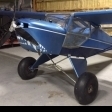Sign in to follow this
Followers
0

Jetting and prop setting
Started by
Good old number 29,
21 posts in this topic
Create an account or sign in to comment
You need to be a member in order to leave a comment
Sign in to follow this
Followers
0